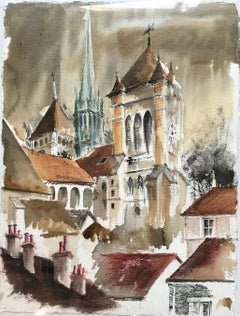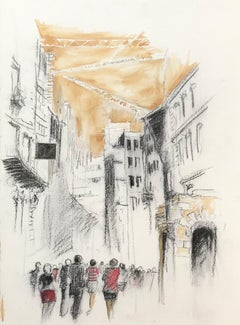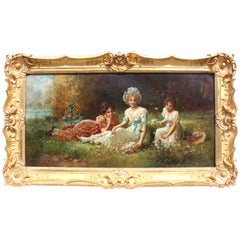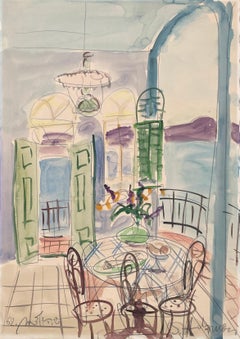Pierre Duc Art
French, b. 1945
Pierre Duc (born in 1945) is a French painter, printmaker and sculptor
A former student of the sculptor Georges Oudot (who created among others the academician swords of Edgar Faure and Jacques Soustelle), he graduated from the School of Fine Arts in Besançon in engraving.
Pierre Duc was a plastic arts teacher at the Lycée de Champagnole and at the IUFM in Franche-Comté.
He has exhibited since 1972 in Besançon, Strasbourg, Paris, Lyon, and takes part in numerous exhibitions, biennials.
Pierre Duc also built monumental sculptures, L'Éternité and Xavier Marmier in Pontarlier, the Fontaine du Temps and the Greyhounds of Belle-Frize in Champagnole, Saint Vernier in Arbois, Une Tranche d'Univers in Crimolois, the Doubs and the Loue in Dole, the two memorials for the veterans of North Africa and Indochina in Dijon, the Vauban of the citadel of Besançon, and created ephemeral works of land art.
Laureate in Cultural Affairs in 1979, first prize in sculpture from the city of Belfort in 1987, first prize at the 1993 Dijon International Festival and Luxeuil in 1996, prize from the General Council of Touraine in 2000.to
1
2
Overall Width
to
Overall Height
to
2
2
2
1
1
2
2
1
1
1
2
10,083
2,779
1,379
1,375
2
2
Artist: Pierre Duc
Cathédrale Saint Pierre Genève by Pierre Duc - Watercolor
By Pierre Duc
Located in Geneva, CH
Watercolor paper
Brown wooden frame with plexiglass
85,5 x 65,7 x 2 cm
Category
Late 20th Century Academic Pierre Duc Art
Materials
Watercolor, Pencil
Lively alley by Pierre Duc - Watercolor
By Pierre Duc
Located in Geneva, CH
Work on arch paper
Black wooden frame with glass pane
87 x 67,5 x 1,5 cm
Category
Late 20th Century Academic Pierre Duc Art
Materials
Watercolor, Pastel
$544 Sale Price
61% Off
Related Items
A Very Fine Austrian Oil on Canvas "Young Ladies Collecting Spring Flowers"
By Hans Zatzka
Located in LA, CA
Hans Zatzka (Austrian, 1859-1945) a very fine and charming oil on canvas ""Young Ladies Collecting Spring Flowers", depicting three young maidens picking flowers by a lake. The three...
Category
Late 19th Century Academic Pierre Duc Art
Materials
Oil
$29,850
H 28.25 in W 48.75 in D 2.5 in
Untitled (Cafe Interior), Shimshon Holzman
By Shimshon Holzman
Located in Fairfield, CT
Artist: Shimshon Holzman (1907-1986)
Title: Untitled (Cafe Interior)
Year: 1962
Medium: Watercolor and graphite on wove paper
Size: 27.75 x 19.75 inches
...
Category
1960s Academic Pierre Duc Art
Materials
Watercolor, Graphite
$2,200 Sale Price
20% Off
H 27.75 in W 19.75 in
"Flat Lands" Original Landscape Mixed Media on Paper by Tom Perkinson, Framed
By Tom Perkinson
Located in Encino, CA
"Flat Lands" is an original mixed media on paper by Tom Perkinson. His use of saturated violets, vivid yellows, and resplendent oranges pushes color to almost-otherworldly realms. Th...
Category
1970s Realist Pierre Duc Art
Materials
Pastel, Ink, Mixed Media, Watercolor, Color Pencil
$5,500
H 26.625 in W 38.375 in D 2.5 in
Architecture Sketches Study Drawing, Romane Church in France by Maurice Lambert
Located in Atlanta, GA
Architectural Study for the Restoration of Saint-Pierre Church in Avon, France.
This unique architectural study was created as part of a church renovation project in a suburb of Pari...
Category
Late 19th Century Academic Pierre Duc Art
Materials
Ink, Watercolor, Pencil
$2,850
H 27.56 in W 40.94 in D 0.82 in
Landscape With Blooming Trees
By Paul Emile Pissarro
Located in Lake Worth Beach, FL
Landscape with Blooming Trees
Paul-Emile Pissarro 1884-1972 French
Paper size 9.5x12.5 under glass framed 12x16x1 signed, very good condition. The backi...
Category
1940s Impressionist Pierre Duc Art
Materials
Paper, Pastel, Gouache
"Plains Indian Camp" Lrg Original Mixed Media on Paper by Tom Perkinson, Framed
By Tom Perkinson
Located in Encino, CA
"Plains Indian Camp" is an original mixed media on paper by Tom Perkinson. His use of saturated violets, vivid yellows, and resplendent oranges pushes colo...
Category
1980s Realist Pierre Duc Art
Materials
Pastel, Ink, Mixed Media, Watercolor, Color Pencil
$8,000
H 32.625 in W 43.125 in D 1 in
"1940 - Number Nine" Original Mixed Media on Board by Tom Perkinson, Framed
By Tom Perkinson
Located in Encino, CA
"1940 - Number Nine" is an original mixed media on board by Tom Perkinson. His use of saturated violets, vivid yellows, and resplendent oranges pushes colo...
Category
1980s Realist Pierre Duc Art
Materials
Pastel, Ink, Mixed Media, Watercolor, Color Pencil
$3,500
H 20.5 in W 32.5 in D 1.125 in
Landscape in Provence Watercolor Painting by Francois Pascal, circa 1940
Located in Atlanta, GA
Step into the serene charm of southern France with this captivating watercolor landscape artwork by François Pascal (France, 19th century–1948). Expertly painted on paper, this work ...
Category
1940s Academic Pierre Duc Art
Materials
Watercolor
$1,800
H 19.13 in W 28.38 in D 1.57 in
“Classic Sailboats”
Located in Southampton, NY
Beautiful, original watercolor on archival paper of two classic American sailboats by the well known marine artist, Ron Saporito Signed by the artist lower right. Condition is excel...
Category
1970s Academic Pierre Duc Art
Materials
Watercolor, Archival Paper
Homeward with Dog and Burden
Located in North Clarendon, VT
This finely painted 19th-century genre scene evokes the crisp chill of winter at the gloaming. As the last pale light glints across a frozen pond, one child hauls a bundle of kindlin...
Category
1860s Academic Pierre Duc Art
Materials
Oil
Early 19th Century English watercolour of woodland near Croxdale Hall
Located in Harkstead, GB
A very attractive and meticulously executed view of a rocky landscape within the woods dating to 1823. This would suit a library or study with its muted tones and skifull draughtsmanship.
William Nicholson (1781-1844)
Near Croxdale Hall
Signed with initials and inscribed with title and date 1823
Pen, ink and grey wash
11 x 8 inches, image only
17 x 13 inches without frame
The portrait-painter and etcher William Nicholson was born in Ovingham-on-Tyne, Northumberland, on Christmas Day 1781. His family transferred to Newcastle when his father was appointed Headmaster of the city's Grammar School. At an early age, though, Nicholson appears to have moved to Hull where he made his artistic debut, painting miniatures of officers garrisoned there. He was almost entirely self-taught, learning his craft through the close study of artworks in private and public galleries. He subsequently returned to Newcastle where he received many commissions to paint portraits of the old families of Northumberland. In 1808, he began to exhibit at the Royal Academy, continuing to do so until 1822. By 1814, Nicholson, whose mother was a Scot, had moved to Edinburgh where he set up as a miniaturist and painter in oils. Soon, however, he began to specialize in watercolour portraits. Early subjects included the actor Daniel Terry and the poet and novelist James Hogg. In 1818 he began to publish a series of Portraits of Eminent Scotsmen, etched from his own portraits and those of other painters. Besides Scott and Hogg, the subjects included the writers Robert Burns, John Wilson ('Christopher North'), and Lord Jeffrey, the painters Sir Henry Raeburn, the divines Alexander Carlyle and Alexander Cameron, the engineer James Watt, the architect John Playfair, and the song-collector and composer George Thomson...
Category
Early 19th Century Academic Pierre Duc Art
Materials
Paper, Watercolor, Ink, Pen
$412 Sale Price
20% Off
H 11 in W 8 in D 1 in
Orientalist View With Characters - Gouache 1894
By Paul Pascal
Located in Saint-Ouen, FR
PASCAL Paul (1832-1903)
Orientalist View With Characters
Gouache on card signed low right and dated 1894
New golden frame
Dim gouache : 42 X 58 cm
Dim Frame : 61 X 78 cm
PASCAL Paul...
Category
1890s Academic Pierre Duc Art
Materials
Gouache
$6,245
H 24.02 in W 30.71 in D 1.58 in
Pierre Duc art for sale on 1stDibs.
Find a wide variety of authentic Pierre Duc art available for sale on 1stDibs. You can also browse by medium to find art by Pierre Duc in paint, watercolor, crayon and more. Much of the original work by this artist or collective was created during the 20th century and is mostly associated with the modern style. Not every interior allows for large Pierre Duc art, so small editions measuring 20 inches across are available. Pierre Duc art prices can differ depending upon medium, time period and other attributes. On 1stDibs, the price for these items starts at $950 and tops out at $1,900, while the average work can sell for $1,900.



